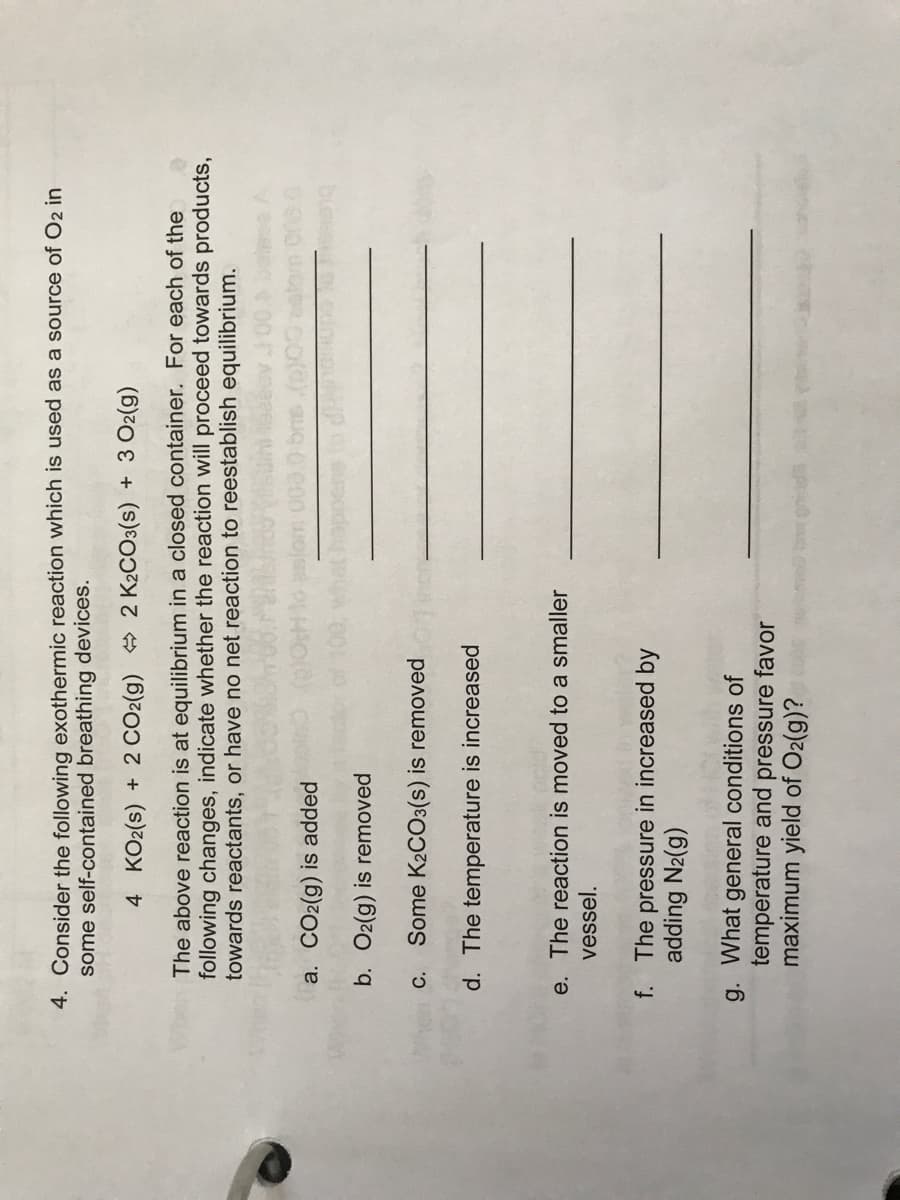4. Consider the following exothermic reaction which is used as a source of O2 in some self-contained breathing devices. 4 KO2(s) + 2 CO2(g) + 2 K2CO3(s) + 3 O2(g) The above reaction is at equilibrium in a closed container. For each of the following changes, indicate whether the reaction will proceed towards products, towards reactants, or have no net reaction to reestablish equilibrium. a. CO2(g) is added b. O2(g) is removed C. Some K2CO3(s) is removed d. The temperature is increased e. The reaction is moved to a smaller vessel. f. The pressure in increased by adding N2(g) g. What general conditions of temperature and pressure favor maximum yield of O2(g)?
4. Consider the following exothermic reaction which is used as a source of O2 in some self-contained breathing devices. 4 KO2(s) + 2 CO2(g) + 2 K2CO3(s) + 3 O2(g) The above reaction is at equilibrium in a closed container. For each of the following changes, indicate whether the reaction will proceed towards products, towards reactants, or have no net reaction to reestablish equilibrium. a. CO2(g) is added b. O2(g) is removed C. Some K2CO3(s) is removed d. The temperature is increased e. The reaction is moved to a smaller vessel. f. The pressure in increased by adding N2(g) g. What general conditions of temperature and pressure favor maximum yield of O2(g)?
Chemistry: An Atoms First Approach
2nd Edition
ISBN:9781305079243
Author:Steven S. Zumdahl, Susan A. Zumdahl
Publisher:Steven S. Zumdahl, Susan A. Zumdahl
Chapter12: Chemical Equilibrium
Section: Chapter Questions
Problem 7ALQ
Related questions
Question
100%

Transcribed Image Text:4. Consider the following exothermic reaction which is used as a source of O2 in
some self-contained breathing devices.
4 KO2(s) + 2 CO2(g) 2 K2CO:(s) + 3 O2(g)
The above reaction is at equilibrium in a closed container. For each of the
following changes, indicate whether the reaction will proceed towards products,
towards reactants, or have no net reaction to reestablish equilibrium.
a. CO2(g) is added
b. O2(g) is removed
C.
Some K2CO3(s) is removed
d. The temperature is increased
e. The reaction is moved to a smaller
vessel.
f. The pressure in increased by
adding N2(g)
g. What general conditions of
temperature and pressure favor
maximum yield of O2(g)? n
Expert Solution
Step 1
Trending now
This is a popular solution!
Step by step
Solved in 3 steps

Knowledge Booster
Learn more about
Need a deep-dive on the concept behind this application? Look no further. Learn more about this topic, chemistry and related others by exploring similar questions and additional content below.Recommended textbooks for you

Chemistry: An Atoms First Approach
Chemistry
ISBN:
9781305079243
Author:
Steven S. Zumdahl, Susan A. Zumdahl
Publisher:
Cengage Learning

Chemistry
Chemistry
ISBN:
9781305957404
Author:
Steven S. Zumdahl, Susan A. Zumdahl, Donald J. DeCoste
Publisher:
Cengage Learning


Chemistry: An Atoms First Approach
Chemistry
ISBN:
9781305079243
Author:
Steven S. Zumdahl, Susan A. Zumdahl
Publisher:
Cengage Learning

Chemistry
Chemistry
ISBN:
9781305957404
Author:
Steven S. Zumdahl, Susan A. Zumdahl, Donald J. DeCoste
Publisher:
Cengage Learning


Chemistry & Chemical Reactivity
Chemistry
ISBN:
9781337399074
Author:
John C. Kotz, Paul M. Treichel, John Townsend, David Treichel
Publisher:
Cengage Learning

Chemistry & Chemical Reactivity
Chemistry
ISBN:
9781133949640
Author:
John C. Kotz, Paul M. Treichel, John Townsend, David Treichel
Publisher:
Cengage Learning

Chemistry for Engineering Students
Chemistry
ISBN:
9781337398909
Author:
Lawrence S. Brown, Tom Holme
Publisher:
Cengage Learning